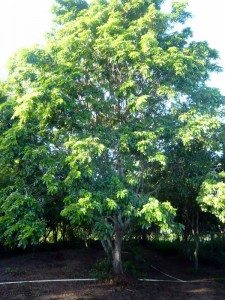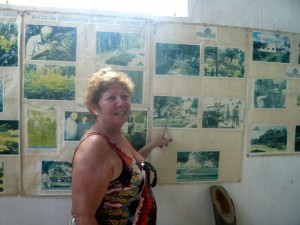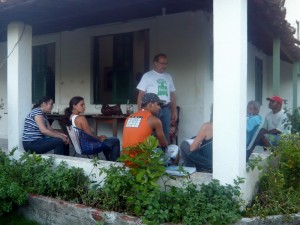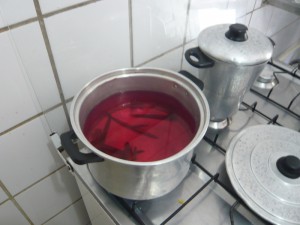 Passamos o último final de semana do mês de abril visitando a sede da Fundação Nacional do Pau Brasil (FUNBRASIL), no Campo da Sementeira em Glória do Goitá/PE. Chegamos à Fundação por uma amiga que conhecemos em Tambaba, Marisa. Com Marisa sonhamos em voz alta sobre a possibilidade de trabalhar com reflorestamento e ela nos disse que tínhamos muito o que apreender com Ana Cristina, a atual presidente da FUNBRASIL.
Passamos o último final de semana do mês de abril visitando a sede da Fundação Nacional do Pau Brasil (FUNBRASIL), no Campo da Sementeira em Glória do Goitá/PE. Chegamos à Fundação por uma amiga que conhecemos em Tambaba, Marisa. Com Marisa sonhamos em voz alta sobre a possibilidade de trabalhar com reflorestamento e ela nos disse que tínhamos muito o que apreender com Ana Cristina, a atual presidente da FUNBRASIL.
On the final weekend of April we visited the National Pau Brazil Foundation (FUNBRASIL) in Glória do Goitá, Pernambuco. We got to know about the foundation through a friend we met in Tambaba, Marisa. We had shared our dream to work with reforestation with her, and she told us that we had a lot to learn from Ana Cristina, the current President of FUNBRASIL.
Ela estava coberta de razão. Ana Cristina, uma mulher de personalidade forte com um coração cheio de solidariedade nos recebeu em sua casa e nos contou um pouco da história da FUNBRASIL e de seus desafios futuros. Ela também nos presenteou com a oportunidade de conhecer e ver de perto o Pau-Brasil, a árvore nacional que inspirou o nome do nosso país e nos fez brasileiros!
She was right. Ana Cristina, a women with a strong personality and a heart full of solidarity, received us in her house and told us about the story of FUNBRASIL and its current challenges. She also gave us the opportunity to get to know the Pau Brasil tree (also known as Brazil wood or Pernambuco), the national tree that inspired the name of our country and turned us into Brazilians.
Fizemos tudo isto regados a boa comida (bacalhau, galinha caipira, k-baby, farofa de jerimum, etc.), boa conversa e boa música. Escutamos muito Forró Pé de Serra e chegamos até a conhecer um autêntico festival de sanfoneiros! Uma maravilha!
We did all this in the midst of good food (bacalhau, free-range chicken, pumpkin farofa, etc.) good conversation and good music. We listened to Forró Pé de Serra (music style from the interior of the Northeast) and even got to be part of a real festival of forró accordionists! Wonderful!
Bem, voltando a FUNBRASIL. A FUNBRASIL é fruto da paixão do pai de Ana Cristina, o Prof. Roldão pelo Pau-Brasil. Considerado por muitos o Apóstolo do Pau-Brasil, ele dedicou toda sua vida para protegê-lo. Em 1970 iniciou o Movimento em Defesa do Pau-Brasil que foi acolhido dois anos mais tarde pela Universidade Federal Rural de Pernambuco (UFRPE). O Movimento ganhou forca, e em 1978, conseguiu que o Pau-Brasil fosse reconhecido pela Lei Federal – 6.607/78 como árvore nacional. A FUNBRASIL é conseqüência deste movimento.
But let’s go back to FUNBRASIL. FUNBRASIL is a result of the passion of Ana Cristina’s father, Professor Roldão. Considered by many the Pau-Brasil apostle, he dedicated his life to protecting this tree. In 1970, he started a movement to defend the Pau-Brasil that was hosted 2 years later by the Federal Rural University of Pernambuco (UFRPE). The movement gained strength and in 1978, managed to have the Pau-Brasil recognized as national tree through a federal law. FUNBRASIL is a consequence of this movement.
 Criada em 1988, ela produz sistemática e continuamente mudas de Pau-Brasil e outras espécies nativas da Mata Atlântica (com uma capacidade de 150.000/200.000 por ano), promove o reflorestamento e educação ambiental e oferece conhecimentos práticos nas disciplinas de Geografia, História e Ecologia ligadas ao Pau-Brasil. Na sede da FUNBRASIL também é possível conhecer o memorial permanente do Pau-Brasil, fazer trilhas ecológicas por entre árvores nativas e conhecer o roteiro histórico-cultural do Pau-Brasil.
Criada em 1988, ela produz sistemática e continuamente mudas de Pau-Brasil e outras espécies nativas da Mata Atlântica (com uma capacidade de 150.000/200.000 por ano), promove o reflorestamento e educação ambiental e oferece conhecimentos práticos nas disciplinas de Geografia, História e Ecologia ligadas ao Pau-Brasil. Na sede da FUNBRASIL também é possível conhecer o memorial permanente do Pau-Brasil, fazer trilhas ecológicas por entre árvores nativas e conhecer o roteiro histórico-cultural do Pau-Brasil.
The foundation, created in 1988, produces seedlings of Pau-Brasil and other native Atlantic Forest tree species (with a capacity of 150.000/200.000 per year), promotes reforestation and environmental education and offers practical knowledge on the Pau-Brasil from geography, history, and ecology. On the campus of FUNBRASIL there is a permanent memorial of the Pau-Brasil, and you can go on ecological hikes between native trees and get to know the historical and cultural Pau-Brasil trail.
Enquanto desfrutávamos de todas estas atividades, Ana Cristina deixava escapar alguns conceitos importantes sobre o reflorestamento e as lições que apreendera com seu pai e na prática. A primeira delas é a importância do conhecimento prático sobre a matéria prima de trabalho, mais de uma vez ela nos disse que para reflorestar “o importante é a planta!”
While we enjoyed all these activities, Ana Cristina shared some important lessons about reforestation with us that she had learned from her father and in her daily work. The first one is the importance of practical knowledge about the prime material of this work. More than once, she told us that to know how to reforest, “the important thing is the plant.”
Com esta frase que parece óbvia, ela faz um protesto contra a quantidade de recursos gastos em discussões sobre política, modelos, organização de conferências, em comparação com o recursos investidos para aprender sobre as plantas mesmo. Ela apela para a necessidade de produzir/disseminar conhecimento sobre qual a melhor técnica para recolher a semente, qual é o período de germinação, qual a melhor época do ano para se plantar as mudas, etc., etc..
With this sentence that seems so obvious, she is criticizing the amount of resources put into discussions about policies, models and the organization of conferences, as opposed to the resources invested in learning about the plants themselves. She calls for the necessity of producing and disseminating knowledge about things like the best techniques to collect seeds, the period of germination for different species, or the best period in the year to plant seedlings, etc., etc.
Aprender mais sobre as plantas é muito vantajoso para quem quer preservar pois pode gerar maior eficiência para reflorestar em termos de tempo e quantidade de plantas que alcançam maturidade e trazer respostas para tornar a preservação economicamente viável.
Learning more about the plants is very advantageous for those wanting to preserve, as it can lead to more efficiency in terms of time and the amount of plants that are able to reach maturity in reforestation projects. It may also help to find answers to turn preservation economically viable.
Por exemplo, depois de vários anos de trabalho com o Pau-Brasil, a FUNBRASIL descobriu que uma das espécies desta planta tem o desenvolvimento de seu cerne mais rápido do que outras. Esta espécie, já aos 17 anos (e não com mais de 30 anos como se pensava) pode ser utilizada para produção de arcos de violino, uma das principais razões para sua exploração.
After several years of work with the Pau-Brasil, for example, FUNBRASIL discovered that a specific type of Pau-Brasil develops his core much faster than others. This species can already be used at 17 years of age (an not with more than 30 as was thought) for the production of violin arches, one of the main reasons for its exploration.
Outra lição que aprendemos com Ana Cristina é a importância de estabelecer uma relação direta com a terra para se tomar consciência da necessidade de proteger, em especial no caso das crianças. Ela gosta de lembrar seus estudantes que atualmente “agimos como crianças que os pais (árvores) as cuidam, limpam suas fraudas, dão de comer e quando crescem se voltam e matam seus pais” e que devemos mudar.
Another lesson we learned from Ana Cristina is the importance of establishing a direct relation with nature, especially for children, to become aware of the necessity to protect. She likes to remind her students that currently “we behave like children taken care of by their parents (the trees), who clean their diapers and give them food, and when they grow up they turn around and kill their parents” and that we have to change that.
Desde o falecimento do Prof. Roldão, a FUNBRASIL enfrenta dificuldades para manter o trabalho vivo. Muitos parceiros antigos conectavam a existência da FUNBRASIL à pessoa do Prof. Roldão e deixaram de apoiar seus trabalhos após sua morte. Além disso, muito dos recursos investidos na FUNBRASIL para defesa do Pau-Brasil e outras árvores nativas vinham diretamente das rendas mensais do professor que já não estão mais disponíveis.
Since the death of Prof. Roldão, FUNBRASIL is confronting difficulties to maintain their work alive. Many long-time partners connected the existence of FUNBRASIL to Prof. Roldão and stopped supporting his work after his death. Besides this, many resources invested in FUNBRASIL for the defense of the Pau-Brasil came from the monthly income of the professor and are not available anymore.
A luta por recursos esbarra na burocracia do setor público e na falta de capital humano para auxiliar com os assuntos burocráticos. Apesar de todos estes desafios, saímos de lá com a certeza de que a FUNBRASIL é dona de um capital enorme que deve ser valorizado. Esta fundação tem o conhecimento técnico e a capacidade para produzir milhares de mudas de Pau-Brasil, Aroeiras, Cajás, Ipês, Ingás, Pau-de Jangada e outros 30 tipos de árvores nativas da Mata Atlântica.
The quest for resources is difficult due to the public sector bureaucracy and the lack of human resources to help with bureaucratic issues. Despite all these challenges, we left FUNBRASIL with the certainty that the foundation is home to an enormous capital that has to be valued and used. This foundation has the technical knowledge and capacity to produce thousands of seedlings of Pau-Brasil, Aroeira, Cajá, Ipê, Ingá, Pau-de-Jangada and other 30 types of native Atlantic Forest trees.
 Os próximos desafios da Fundação incluem vencer o isolamento que se encontra atualmente e conseguir parceiros alternativos ao setor público. Estas parcerias podem promover sua inserção no mundo eletrônico e no novo mercado da vida que está emergindo com o arrocho da legislação ambiental e da consciência para a necessidade de preservação.
Os próximos desafios da Fundação incluem vencer o isolamento que se encontra atualmente e conseguir parceiros alternativos ao setor público. Estas parcerias podem promover sua inserção no mundo eletrônico e no novo mercado da vida que está emergindo com o arrocho da legislação ambiental e da consciência para a necessidade de preservação.
The challenges the foundation has to face next, include getting out of the isolation it find itself in currently, and finding partners other than the public sector. These partnerships can promote its integration into the electronic world and into the new market of life that is emerging with stricter environmental legislation and an increased awareness for the necessity to preserve.
As mudas de árvores nativas estão disponíveis para empresas e indivíduos que queiram ou precisam reflorestar. Caso você tenha interesse em adquirir mudas ou sementes de Pau-Brasil ou outras espécies raras da Mata Atlântica, contribuir ou conhecer a Fundação entre em contato com Ana Cristina através do e-mail (funbrasil [at] yahoo.com.br) ou no telefone ((081) 9909-2934).
The seedlings of native trees are available to companies and individual who want to or need to reforest. If you are interested in buying seedlings or seeds of Pau-Brasil or other rare species of the Atlantic Forest, or if you want to support or get to know or support the foundation, get in touch with Ana Cristina by email (funbrasil [at] yahoo.com.br) or by phone ((081) 9909 2934).
“A natureza é anti-capitalista porque ela investe o máximo possível, durante um longo período de tempo, para que pelo menos um indivíduo possa sobreviver. Enquanto o capitalismo prega o menor investimento possível, no menor espaço de tempo, para obter o máximo de retorno possível.”
“Nature is anti-capitalist because she invests the maximum, over a long period of time, so that at least one individual can survive. Capitalism, by contrast, requires to invest the least possible, in as little time as possible, to obtain the biggest return possible.”
Mais informações:
More information:


A preucupação com a degradação ambiental brasileira não é recemte, como se pensas usualmente, e nem se originou a partir de idéias importadas da Europa e dos Estados Unidos(Pádua)1999. As primeiras manuisfestações contra a destruição ambiental no Brasil surgiram na Europa no segundo seculo de colonização, pelo cronista e senhor de engenho Ambrósio Fernandes Brandão que em 1618 já fazia criticas ambientais aos propietários de terras e também de Frei Vicente Salvador(1554-1636), que condenou os colonizadores por destruirem a terra que cultivavam Historia do Brasil.